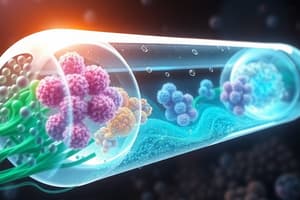Podcast
Questions and Answers
What is the primary function of mitochondria in a cell?
What is the primary function of mitochondria in a cell?
- Conduct photosynthesis
- Store genetic information
- Generate energy (correct)
- Remove waste
Chloroplasts require energy from the sun to conduct photosynthesis.
Chloroplasts require energy from the sun to conduct photosynthesis.
True (A)
What process allows substances to move from higher to lower concentration without energy?
What process allows substances to move from higher to lower concentration without energy?
Diffusion
___ is the type of active transport that allows particles to enter the cell by the cell membrane folding around them.
___ is the type of active transport that allows particles to enter the cell by the cell membrane folding around them.
Which statement about exocytosis is correct?
Which statement about exocytosis is correct?
Facilitated diffusion requires energy to move molecules across the cell membrane.
Facilitated diffusion requires energy to move molecules across the cell membrane.
The main component of plant cells that gives it structure is the ___ membrane.
The main component of plant cells that gives it structure is the ___ membrane.
What type of transport involves moving molecules from lower to higher concentration?
What type of transport involves moving molecules from lower to higher concentration?
Match the following transport processes with their key characteristics.
Match the following transport processes with their key characteristics.
What type of particles can pass through the tubing in diffusion?
What type of particles can pass through the tubing in diffusion?
Flashcards
DNA function
DNA function
DNA stores instructions for cell activities.
Mitochondria function
Mitochondria function
Produces energy for the cell.
Chloroplast function
Chloroplast function
Uses sunlight to make food (photosynthesis).
Exocytosis
Exocytosis
Signup and view all the flashcards
Diffusion
Diffusion
Signup and view all the flashcards
Facilitated Diffusion
Facilitated Diffusion
Signup and view all the flashcards
Active Transport
Active Transport
Signup and view all the flashcards
Endocytosis
Endocytosis
Signup and view all the flashcards
Cell Membrane
Cell Membrane
Signup and view all the flashcards
Ribosomes
Ribosomes
Signup and view all the flashcards
Study Notes
Cellular Structures and Processes
- DNA stores instructions for cellular functions.
- Mitochondria are the cell's energy producers.
- Chloroplasts perform photosynthesis, converting sunlight into food.
- Exocytosis removes molecules from the cell.
- Smaller cells have a higher waste removal rate.
- Ribosomes are present in plant, animal, and bacterial cells.
Cell Transport Mechanisms
- Diffusion: Movement of molecules from high to low concentration, no energy required; only smaller particles pass through the membrane.
- Facilitated Diffusion: Similar to diffusion, but larger molecules can pass through a protein channel, no energy required.
- Active Transport: Movement of molecules against the concentration gradient (low to high), requires energy and protein channels.
- Endocytosis: Active transport process that brings molecules into the cell by folding the membrane inwards. Requires energy and membrane rearrangement.
- Exocytosis: Active transport process that removes molecules from the cell by fusing vesicles with the membrane. Requires energy and membrane rearrangement.
Cell Membrane
- The cell membrane acts as a barrier during diffusion, only allowing small molecules to pass.
- Starch molecules are too large to pass through the membrane, while smaller sugar molecules can.
- Plant cells have a more structured membrane contributing to their shape.
Studying That Suits You
Use AI to generate personalized quizzes and flashcards to suit your learning preferences.




